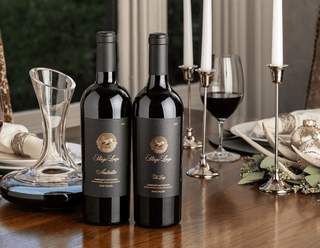Seven Types of Wine Varietals
Picking the perfect pour for any occasion can be easier when you are familiar with the most popular wine varietals. The term "varietal" refers to the principal grapes or contributing fruits used to produce wine, which imparts distinctive color and flavor properties. Find out more about how grape varietals factor into winemaking and discover seven of the most popular Napa Valley varietals.
An Intro to Wine Varietals
The specific types of grapes used to make a particular wine are called varietals. The same varietal can take on different characteristics based on the climate where grapes are grown. Varietals are often grown and barrel-aged separately. The final assemblage of most red and white blends occurs just before the wine is bottled.
Stags' Leap Winery sources fruit from various microclimates in Napa Valley to craft primary varietal wines and blends. The 85-acre Estate Vineyard is divided into 23 separate blocks based on soil type and exposure to the sun, in a combination of valley floor and hillside slope plantings. Each block perfectly matches each grape variety to its ideal soil type. Most of the blocks are planted to cabernet sauvignon, petite sirah, and merlot.
1. Cabernet Sauvignon
Cabernet Sauvignon is synonymous with Napa Valley and has always been a mainstay in the winemaking program at Stags’ Leap Winery. Our Stags' Leap Napa Valley Cabernet Sauvignon is a combination of estate fruit and grapes from select Napa Valley growers with a focus on sourcing from the valley floor.
2. Chardonnay
The chardonnay varietal is also popular in Napa and is used as a primary varietal for wine such as our Stags' Leap 2020 Napa Valley Chardonnay. Experience the most expressive barrel lots in each vintage in our Stags' Leap Barrel Selection Chardonnay.
3. Merlot
One of the better-known red varietals beyond cabernet sauvignon, merlot is a smooth sip with a soft finish. California merlot is more fruity and less tannic than the same varietal cultivated in cooler climates. Our Stags' Leap Napa Valley Merlot is a beautiful example of a Napa Valley merlot.
4. Malbec
Malbec is a varietal with floral characteristics and vibrant aromatics. This varietal accentuates these properties in Cabernet blends. Our Stags' Leap The Investor 2019 Red Wine blend unites merlot, petite sirah, and cabernet sauvignon with malbec.
5. Petite Sirah
Petite sirah is a less common varietal originating in France that is now popular in California. This varietal is not simply a smaller version of Syrah, but the offspring of Syrah and the nearly extinct Peloursin grape. Petite sirah is a varietal that is enhanced by the deliberate diversity of our vineyard sites. Grapes from the vineyards located on our estate's deep, rocky soils make up the backbone of our Stags' Leap Napa Valley Petite Sirah.
6. Petit Verdot
Petit Verdot originated as a blending grape for Bordeaux. In warmer climates like Napa Valley, this varietal becomes less tannic over time and displays floral and fruity characteristics.
7. Viognier
Viognier is a white grape varietal with more natural aromatics than Chardonnay. Like Chardonnay, Viognier has the potential to produce full-bodied wines with a lush, soft character. In contrast to Chardonnay, the Viognier varietal has more natural aromatics that include notes of peach, pears, violets, and minerality. Our Stags' Leap Napa Valley Viognier is sourced from select vineyards in the Oak Knoll and Carneros AVAs, these cooler vineyards are optimal for growing Viognier, providing sufficient sun exposure for ripening and cool marine fog for maintaining natural acidity.
Tips for Selecting Wine Varietals
As you delve deeper into wine culture, it can be helpful to consider the properties of regional varietals. You can also refer to tasting, vintage, vineyard, and winemaking notes for each vintage.
Learn more about Stags' Leap wine varietals to guide your choice of the right wine to complement food or tantalize your taste buds. We grow several varietals across several microclimates in the greater Napa Valley.



